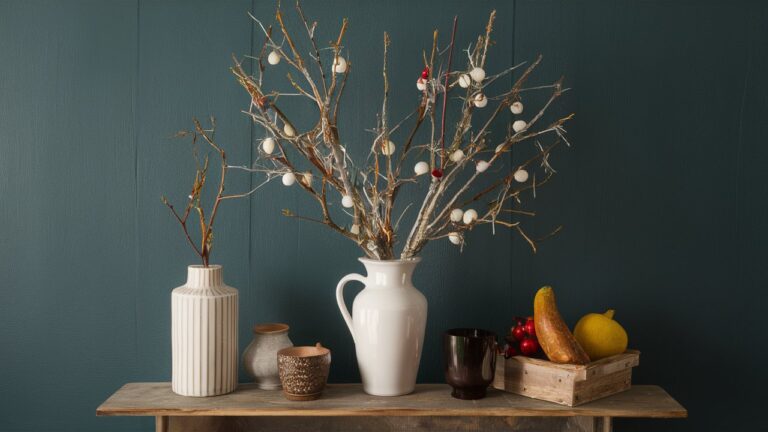Introduction
There’s something irresistibly timeless about bringing nature indoors—especially when it’s done through pyntekvister, the Scandinavian art of using decorative branches. Whether you’re drawn to minimalism, sustainable decor, or creative DIY projects, learning how to work with pyntekvister can help you transform your space into an environment that feels calm, connected, and profoundly personal. Rooted in Nordic tradition, these understated arrangements allow every season to shine in your home—from budding spring twigs to cozy winter branches wrapped in fairy lights. In this guide, we’ll explore what makes pyntekvister so versatile, how to make them yourself, and how to display them beautifully year-round.
Embracing the Beauty and Practicality of Pyntekvister
“Pyntekvister” literally translates to decorative twigs in Norwegian or Danish—and while that may sound simple, their impact in interior design is anything but ordinary. Traditionally, people in Scandinavia collected branches from birch, cherry, willow or hazel—cleaning and decorating them during long, dark winters to bring life indoors Verse Magazineiotavalley.comheightmag.com. What began as modest seasonal gestures has evolved into warm, nature-inspired décor that fits minimalist apartments and rustic farmhouses alike interiorredoux.comgreenecodream.comDiffer.
Today, ways of designing with pyntekvister span—from bare, sculptural branches to painted versions in metallic tones, even branches lit delicately with LEDs to brighten a Nordic winter’s darkness heightmag.com+1Raw Magazine. The charm lies in their simplicity, uniqueness, and inherent connection to nature—no two branches are ever alike, which makes each arrangement distinct and captivating interiorredoux.comRaw Magazine.
DIY Ideas: Creating Your Own Pyntekvister
1. Natural Branch Centerpiece
Gather branches—birch, curly willow, cherry—straight from your garden or park (responsibly of course). Clean, dry, and perhaps oil or lightly sand them to enhance texture. Place them tall in a narrow ceramic or glass vase filled with stones or sand. The raw, elegant lines become a statement piece that grounds any room heightmag.comiotavalley.com.
2. Painted or Metallic Transformations
Want something bolder? Spray paint bare branches in white, gold, copper, or pastel shades. This instantly elevates them for festive seasons or modern interiors. White-painted branches, for instance, work especially well in winter-themed décor heightmag.comiotavalley.com.
3. Lighted Twigs for Ambient Glow
Wire delicate LED branches around dry twigs to introduce ambiance and warmth—especially effective in darker months when natural light wanes heightmag.com. The combination is visually enchanting and utterly effortless to place.
4. Seasonal DIY Display Station
Create a ritual: each season, redecorate your base arrangement. For spring, add blossoms or pastel ribbons. In summer, weave in wildflowers or greenery. For autumn, attach dried leaves, berries, or miniature pumpkins. Winter invites snowflake ornaments or fairy lights heightmag.comiotavalley.com. This rotating décor becomes a living reflection of the changing year.
Display Styles That Enhance Every Corner
Centerpiece Inspiration
Tall vases with natural or painted branches make elegant centerpieces—whether on dining tables or entry consoles interiorredoux.comheightmag.com.
Wall or Hanging Displays
Mount branches to create organic wall art—curving them into shapes or hanging them horizontally from which to clip photos, ornaments, or postcards interiorredoux.comheightmag.com. Small arrangements near bathroom mirrors or in entryways can make compact spaces feel thoughtfully styled spacecoastinsight.com.
Seasonal Layering with Natural Elements
Combine pyntekvister with wreaths, dried florals, driftwood, or ceramic vases to add depth and tactility to your arrangements heightmag.com.
Care Tips and Sustainability
Natural branches last for months or even years—especially if stored dry and dusted regularly heightmag.comiotavalley.com. Fresh flowering branches can stay fresh in water for 1–3 weeks heightmag.com. Painted or LED versions benefit from careful storage—wrap them to prevent scratches or damage heightmag.comspacecoastinsight.com. This sustainability and reusability not only look beautiful—they reduce waste, support eco-conscious decorating, and bring an authentic connection to nature into your home Differgreenecodream.comRaw Magazine.
Conclusion
In a world of mass-produced décor, pyntekvister stand out as naturally beautiful, eco-sensitive, and endlessly adaptable. Whether you prefer pristine minimalism, rustic coziness, or creatively painted branches, there’s something inherently soothing and timeless about bringing decorative twigs into your living space. Best of all, they invite you into a gentle, seasonal dance—allowing your decor to evolve, reminding us of nature’s quiet rhythms.
FAQ (Frequently Asked Questions)
1. What are Pyntekvister?
“Pyntekvister” is a Scandinavian term meaning decorative twigs or branches. It refers to branches—often birch, willow, hazel, or cherry—used indoors to bring natural beauty into homes, typically arranged in vases or as wall decor heightmag.comVerse Magazineiotavalley.com.
2. How do I style Pyntekvister in small spaces?
Use compact arrangements placed near mirrors, sinks, or on shelves. Wall mounting smaller branches or creating hanging displays adds visual interest without crowding the space spacecoastinsight.com.
3. Can Pyntekvister be reused year after year?
Yes! Natural branches can last months or even years if kept dry and clean. Painted or LED versions can be stored wrapped carefully and reused for future seasons heightmag.comiotavalley.com.
4. Do I have to use real branches?
No. You can opt for artificial versions made from plastic or resin—which require no upkeep and remain consistent over time spacecoastinsight.com.
5. Are Pyntekvister eco-friendly?
Absolutely. When sourced responsibly or repurposed at home, they’re sustainable, reduce reliance on mass-produced items, and align well with mindful, nature-inspired living DifferRaw Magazine.
6. Where can I find Pyntekvister?
You can gather them in nature (with permission!), or find them at florists, home décor shops, garden centers, and online retailers—many featuring pre-decorated or painted branches interiorredoux.comiotavalley.comspacecoastinsight.com.
